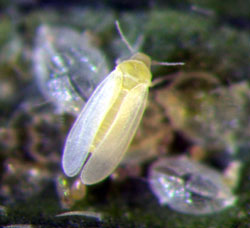Whiteflies are not just impacting vegetables and cotton this year. According to the University of Georgia Integrated Pest Management blog, whitefly populations are impacting blueberries in Georgia. Since harvest season ended, University of Georgia blueberry entomologist Ash Sial has fielded calls of whitefly infestations in major blueberry-producing counties in Georgia.

Professor, IPM-Biological Control of Insects and Mites
Mid-Florida Research and Education Center
UF/IFAS
In the past, UGA blueberry experts have identified heavy infestations of Tetraleurodes ursorum Cockerell (Aleyrodidae: Hemiptera). Also referred to as the “bearberry whitefly,” it was first reported on the common bearberry (Arctostaphylos uva-ursi) on Flagstaff Mountain in Boulder, Colorado.
Bearberry whiteflies are primarily postharvest feeders, and the prevalence of whitefly infestation in Georgia blueberries has significantly increased over the past couple of years. In most instances, infestations occur in small patches and do not seem to cause economic damage. However, if high level of infestations is observed throughout the field, insecticide treatment may be needed to control this pest.
Treatment Options
An application of Admire Pro (via drip irrigation), Assail (foliar spray application) or Movento (foliar spray application) will help with control. When using insecticides, always read and follow the label instructions. Because whiteflies are small and feed on underside of the leaves, spray coverage is extremely important to control them. Thus, using high spray volumes (~80-100 gallons per acre) is highly recommended to achieve the desired level of spray coverage to control whiteflies.
Bearberry whitefly pupae are oval, shiny black, about 0.7 mm (0.03 inch) long and 0.5 mm (0.02 inch) broad. Adults are about 1 mm (0.04 inch) long. The body from the above is blackish and covered with white mealy wax. The base and sides of the abdomen are white, the extreme base of wings yellow, and lower surface of the abdomen is light yellow with the last two segments gray. The eyes are black and completely divided, and the wings are white.
Eggs hatch to a mobile first instar, commonly known as crawlers. Once crawlers find a suitable location to feed and settle, they mature through a few stationary nymphal stages that feed to a final non-feeding nymphal instar, often called a pupa. The term pupa is a misnomer, a loose use of entomological nomenclature, because whiteflies do not truly develop through complete metamorphosis. Bearberry whiteflies colonize the underside of the blueberry leaves; the adults and eggs are commonly found on the lower surface of younger leaves whereas nymphal stages on somewhat older and mature leaves. Whiteflies have piercing-sucking (needle-like) mouthparts.
They feed by inserting mouthparts into plant tissue and sucking the flowing sap or phloem. While feeding, they excrete a sweet, sticky liquid referred to as “honeydew”. Sometimes, they reach such high populations that cover the lower surface of the leaves with nymphs, pupae, and their associated honeydew. The honeydew excreted by nymphs can collect dust, lead to growth of sooty mold, and attract ants.









